Strategic Management Case Study Analysis: Tesco's Business Strategy
VerifiedAdded on 2023/01/12
|11
|3518
|73
Case Study
AI Summary
This document provides a detailed strategic management case study analysis focusing on Tesco, a major British grocery supermarket chain. It explores the processes companies use to analyze their strategies, including external and internal analysis, and evaluates the models and tools employed, such as PESTEL and SWOT analyses. The study applies these tools within the context of Tesco, examining its strengths, weaknesses, opportunities, and threats. Furthermore, the analysis emphasizes the importance of change management based on transformation processes. The document covers Tesco's political, economic, social, technological, environmental, and legal factors, as well as its internal capabilities. This comprehensive analysis offers insights into Tesco's strategic approach and its adaptation to its competitive environment.
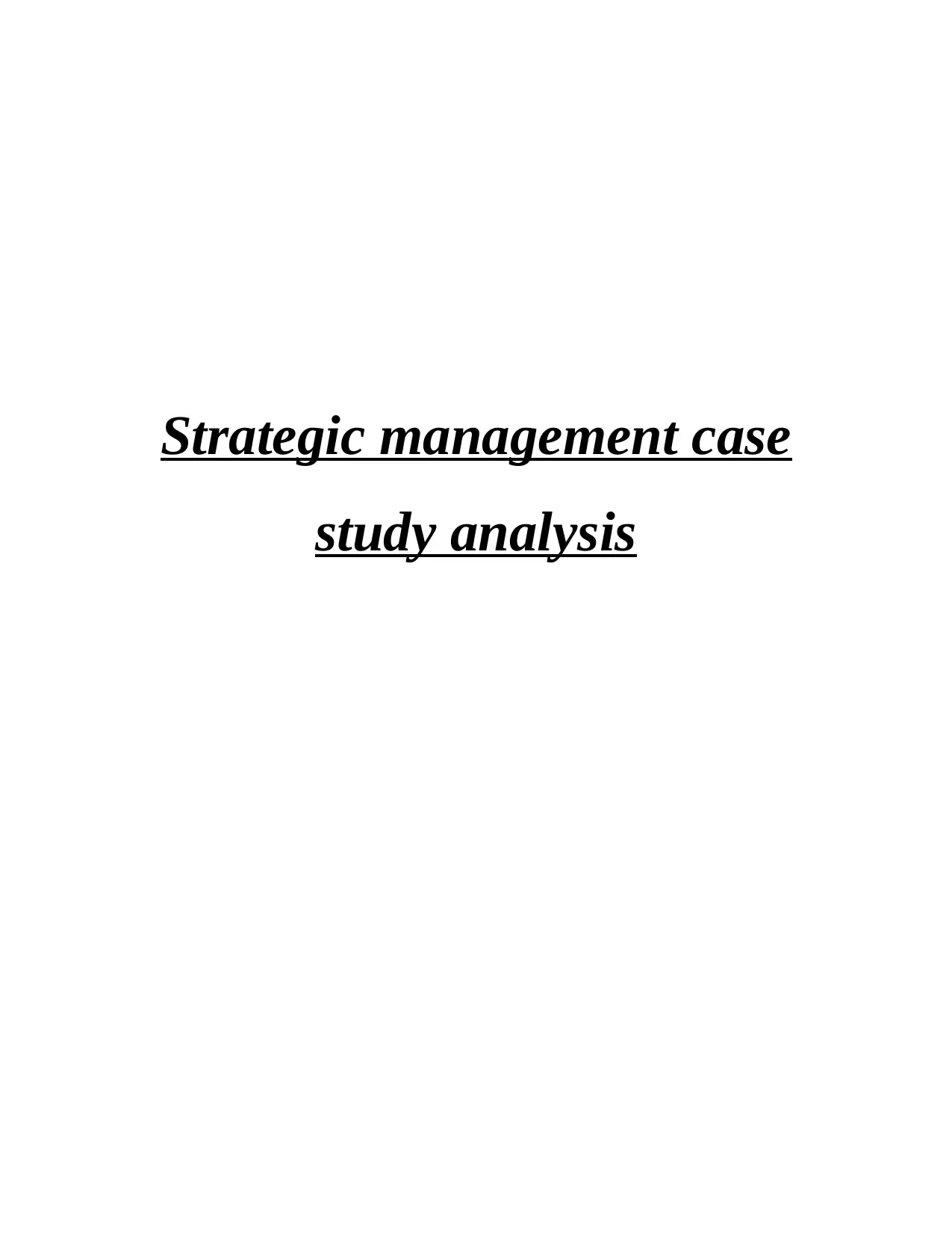
Strategic management case
study analysis
study analysis
Paraphrase This Document
Need a fresh take? Get an instant paraphrase of this document with our AI Paraphraser
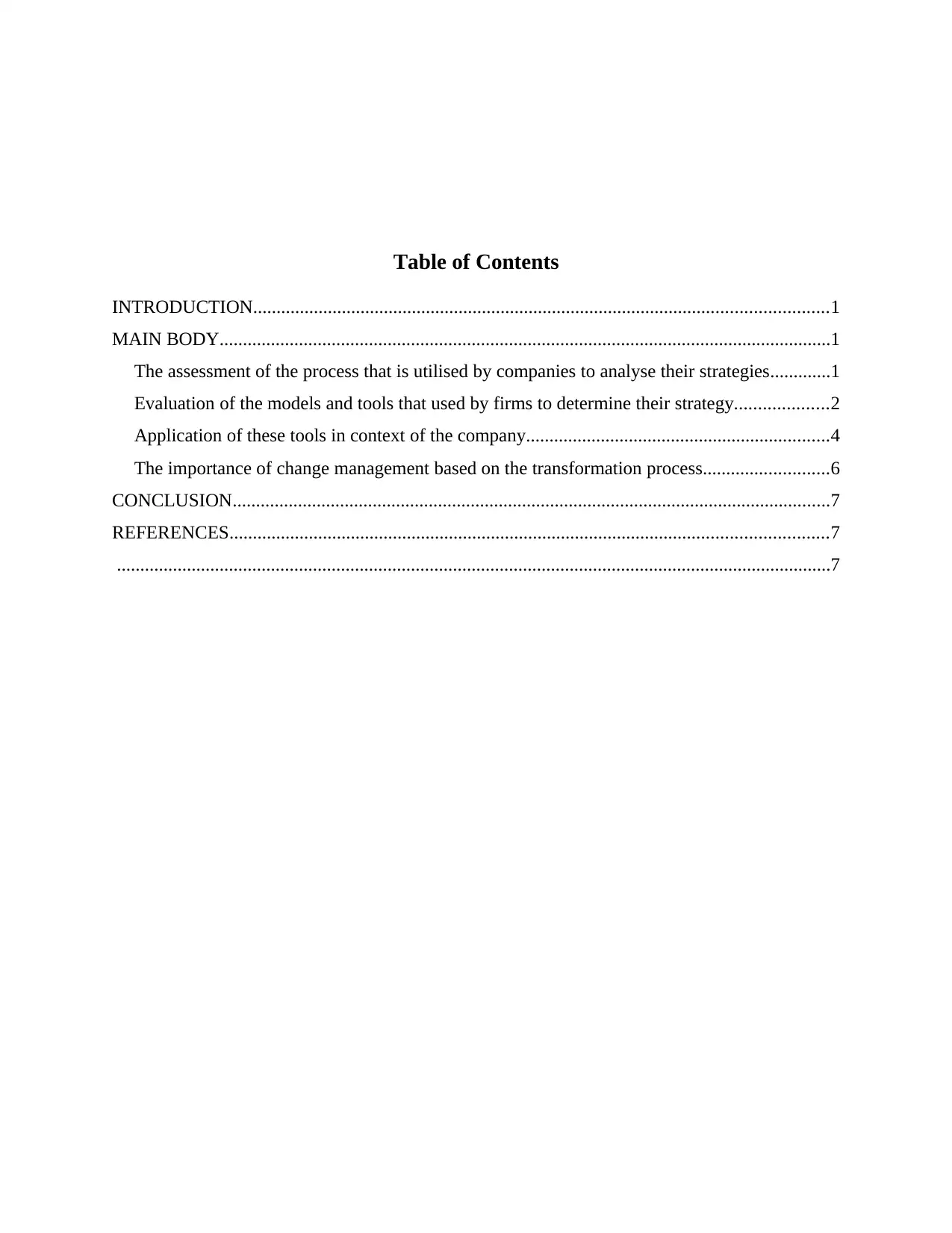
Table of Contents
INTRODUCTION...........................................................................................................................1
MAIN BODY...................................................................................................................................1
The assessment of the process that is utilised by companies to analyse their strategies.............1
Evaluation of the models and tools that used by firms to determine their strategy....................2
Application of these tools in context of the company.................................................................4
The importance of change management based on the transformation process...........................6
CONCLUSION................................................................................................................................7
REFERENCES................................................................................................................................7
.........................................................................................................................................................7
INTRODUCTION...........................................................................................................................1
MAIN BODY...................................................................................................................................1
The assessment of the process that is utilised by companies to analyse their strategies.............1
Evaluation of the models and tools that used by firms to determine their strategy....................2
Application of these tools in context of the company.................................................................4
The importance of change management based on the transformation process...........................6
CONCLUSION................................................................................................................................7
REFERENCES................................................................................................................................7
.........................................................................................................................................................7

INTRODUCTION
Strategic management refers to an activity of setting goals and objectives, determining
competitive environment, monitoring internal organisation, measuring plan of action and
assuring that administration rolls out the tactics cross wise the firm. It can be a continuous
planning, determination and assessment all the required things that are necessary to meet
organisation’s aims and objectives. This written document is based on Tesco which is a British
largest grocery supermarket chain (Albers and et. al., 2017). This organisation was incorporated
in 1919 by Jack Cohen in Hertfordshire, UK. The report will discuss about the process that is
used by companies to analyse their strategy and the concept or tools that is used by firm to
monitor their plan of action. Further, will explain about application of these tools and the
importance of change management that is based on the transformation process.
MAIN BODY
The assessment of the process that is utilised by companies to analyse their strategies
In reference to make sure efficaciousness in execution, there are numerous processes that
can be basically used by organisations to create their plan and tactics or put the same impact
effectively. These activities are needed to be critically utilised in reference to determine their
effectiveness regarding proper formulation of the strategy. Some of the appropriate processes in
this context are defined as under:
External analysis
One of the large processes in reference to analyse the strategy is connected to the analysis
of the macro environment. It indicates to the evaluation of all the components within the
extrinsic business atmosphere of an organisation that has a wide impact over its business
determination and plan of actions. This activity needs the organisation in reference to determine
components that are connected with the political stableness, economical condition, social needs,
technological advancement and environmental concern as well as effective consideration of legal
needs in the business sector (Ansoff and et. al., 2018). Along with it, this action is
comprehensive to determination of industrial position of a company regarding customers,
suppliers, new venture in the market and existing competitive companies. All these forces have
create direct impact on the company and decision making of firm regarding formulation of
strategies and improving competitive position in market.
1
Strategic management refers to an activity of setting goals and objectives, determining
competitive environment, monitoring internal organisation, measuring plan of action and
assuring that administration rolls out the tactics cross wise the firm. It can be a continuous
planning, determination and assessment all the required things that are necessary to meet
organisation’s aims and objectives. This written document is based on Tesco which is a British
largest grocery supermarket chain (Albers and et. al., 2017). This organisation was incorporated
in 1919 by Jack Cohen in Hertfordshire, UK. The report will discuss about the process that is
used by companies to analyse their strategy and the concept or tools that is used by firm to
monitor their plan of action. Further, will explain about application of these tools and the
importance of change management that is based on the transformation process.
MAIN BODY
The assessment of the process that is utilised by companies to analyse their strategies
In reference to make sure efficaciousness in execution, there are numerous processes that
can be basically used by organisations to create their plan and tactics or put the same impact
effectively. These activities are needed to be critically utilised in reference to determine their
effectiveness regarding proper formulation of the strategy. Some of the appropriate processes in
this context are defined as under:
External analysis
One of the large processes in reference to analyse the strategy is connected to the analysis
of the macro environment. It indicates to the evaluation of all the components within the
extrinsic business atmosphere of an organisation that has a wide impact over its business
determination and plan of actions. This activity needs the organisation in reference to determine
components that are connected with the political stableness, economical condition, social needs,
technological advancement and environmental concern as well as effective consideration of legal
needs in the business sector (Ansoff and et. al., 2018). Along with it, this action is
comprehensive to determination of industrial position of a company regarding customers,
suppliers, new venture in the market and existing competitive companies. All these forces have
create direct impact on the company and decision making of firm regarding formulation of
strategies and improving competitive position in market.
1
⊘ This is a preview!⊘
Do you want full access?
Subscribe today to unlock all pages.

Trusted by 1+ million students worldwide
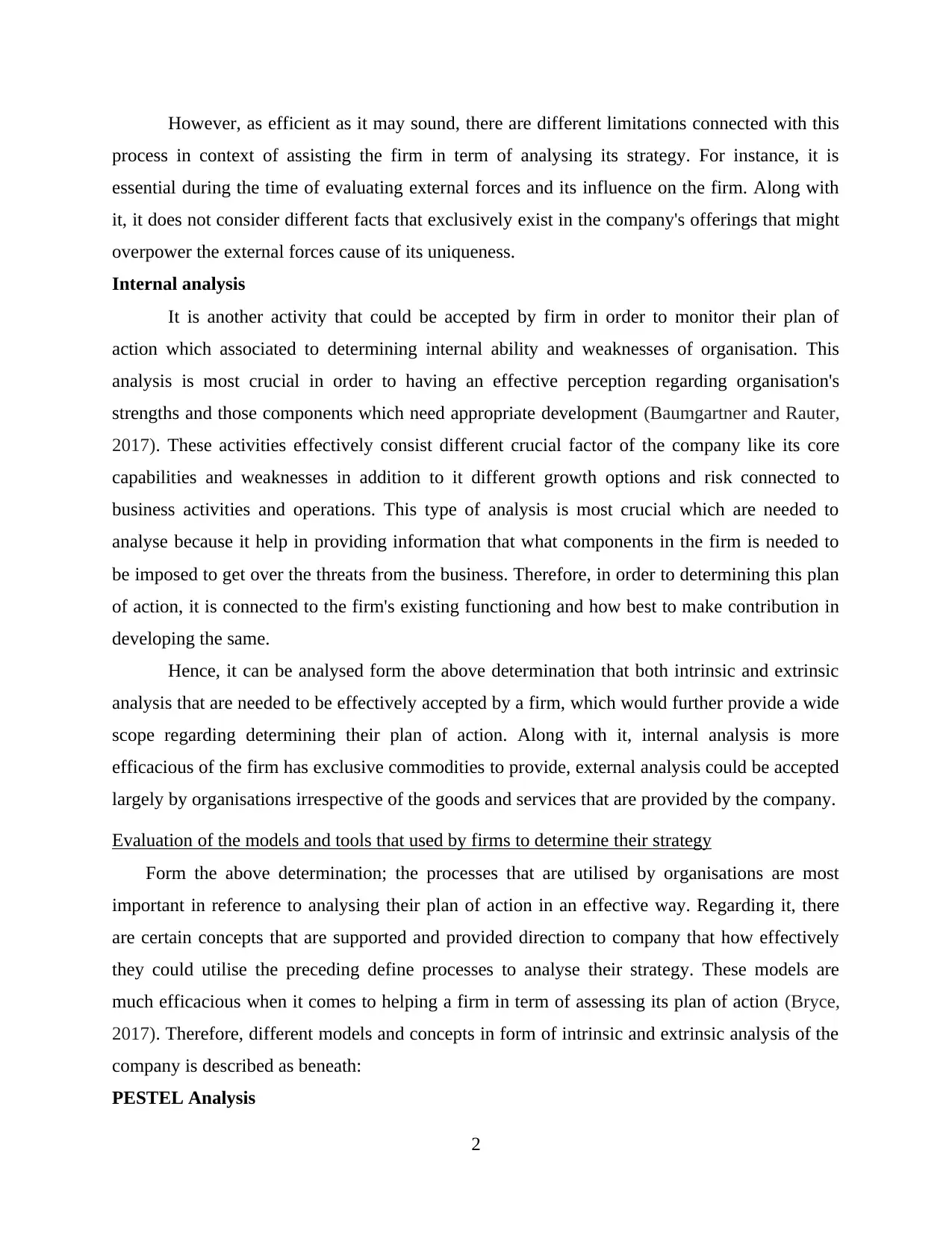
However, as efficient as it may sound, there are different limitations connected with this
process in context of assisting the firm in term of analysing its strategy. For instance, it is
essential during the time of evaluating external forces and its influence on the firm. Along with
it, it does not consider different facts that exclusively exist in the company's offerings that might
overpower the external forces cause of its uniqueness.
Internal analysis
It is another activity that could be accepted by firm in order to monitor their plan of
action which associated to determining internal ability and weaknesses of organisation. This
analysis is most crucial in order to having an effective perception regarding organisation's
strengths and those components which need appropriate development (Baumgartner and Rauter,
2017). These activities effectively consist different crucial factor of the company like its core
capabilities and weaknesses in addition to it different growth options and risk connected to
business activities and operations. This type of analysis is most crucial which are needed to
analyse because it help in providing information that what components in the firm is needed to
be imposed to get over the threats from the business. Therefore, in order to determining this plan
of action, it is connected to the firm's existing functioning and how best to make contribution in
developing the same.
Hence, it can be analysed form the above determination that both intrinsic and extrinsic
analysis that are needed to be effectively accepted by a firm, which would further provide a wide
scope regarding determining their plan of action. Along with it, internal analysis is more
efficacious of the firm has exclusive commodities to provide, external analysis could be accepted
largely by organisations irrespective of the goods and services that are provided by the company.
Evaluation of the models and tools that used by firms to determine their strategy
Form the above determination; the processes that are utilised by organisations are most
important in reference to analysing their plan of action in an effective way. Regarding it, there
are certain concepts that are supported and provided direction to company that how effectively
they could utilise the preceding define processes to analyse their strategy. These models are
much efficacious when it comes to helping a firm in term of assessing its plan of action (Bryce,
2017). Therefore, different models and concepts in form of intrinsic and extrinsic analysis of the
company is described as beneath:
PESTEL Analysis
2
process in context of assisting the firm in term of analysing its strategy. For instance, it is
essential during the time of evaluating external forces and its influence on the firm. Along with
it, it does not consider different facts that exclusively exist in the company's offerings that might
overpower the external forces cause of its uniqueness.
Internal analysis
It is another activity that could be accepted by firm in order to monitor their plan of
action which associated to determining internal ability and weaknesses of organisation. This
analysis is most crucial in order to having an effective perception regarding organisation's
strengths and those components which need appropriate development (Baumgartner and Rauter,
2017). These activities effectively consist different crucial factor of the company like its core
capabilities and weaknesses in addition to it different growth options and risk connected to
business activities and operations. This type of analysis is most crucial which are needed to
analyse because it help in providing information that what components in the firm is needed to
be imposed to get over the threats from the business. Therefore, in order to determining this plan
of action, it is connected to the firm's existing functioning and how best to make contribution in
developing the same.
Hence, it can be analysed form the above determination that both intrinsic and extrinsic
analysis that are needed to be effectively accepted by a firm, which would further provide a wide
scope regarding determining their plan of action. Along with it, internal analysis is more
efficacious of the firm has exclusive commodities to provide, external analysis could be accepted
largely by organisations irrespective of the goods and services that are provided by the company.
Evaluation of the models and tools that used by firms to determine their strategy
Form the above determination; the processes that are utilised by organisations are most
important in reference to analysing their plan of action in an effective way. Regarding it, there
are certain concepts that are supported and provided direction to company that how effectively
they could utilise the preceding define processes to analyse their strategy. These models are
much efficacious when it comes to helping a firm in term of assessing its plan of action (Bryce,
2017). Therefore, different models and concepts in form of intrinsic and extrinsic analysis of the
company is described as beneath:
PESTEL Analysis
2
Paraphrase This Document
Need a fresh take? Get an instant paraphrase of this document with our AI Paraphraser
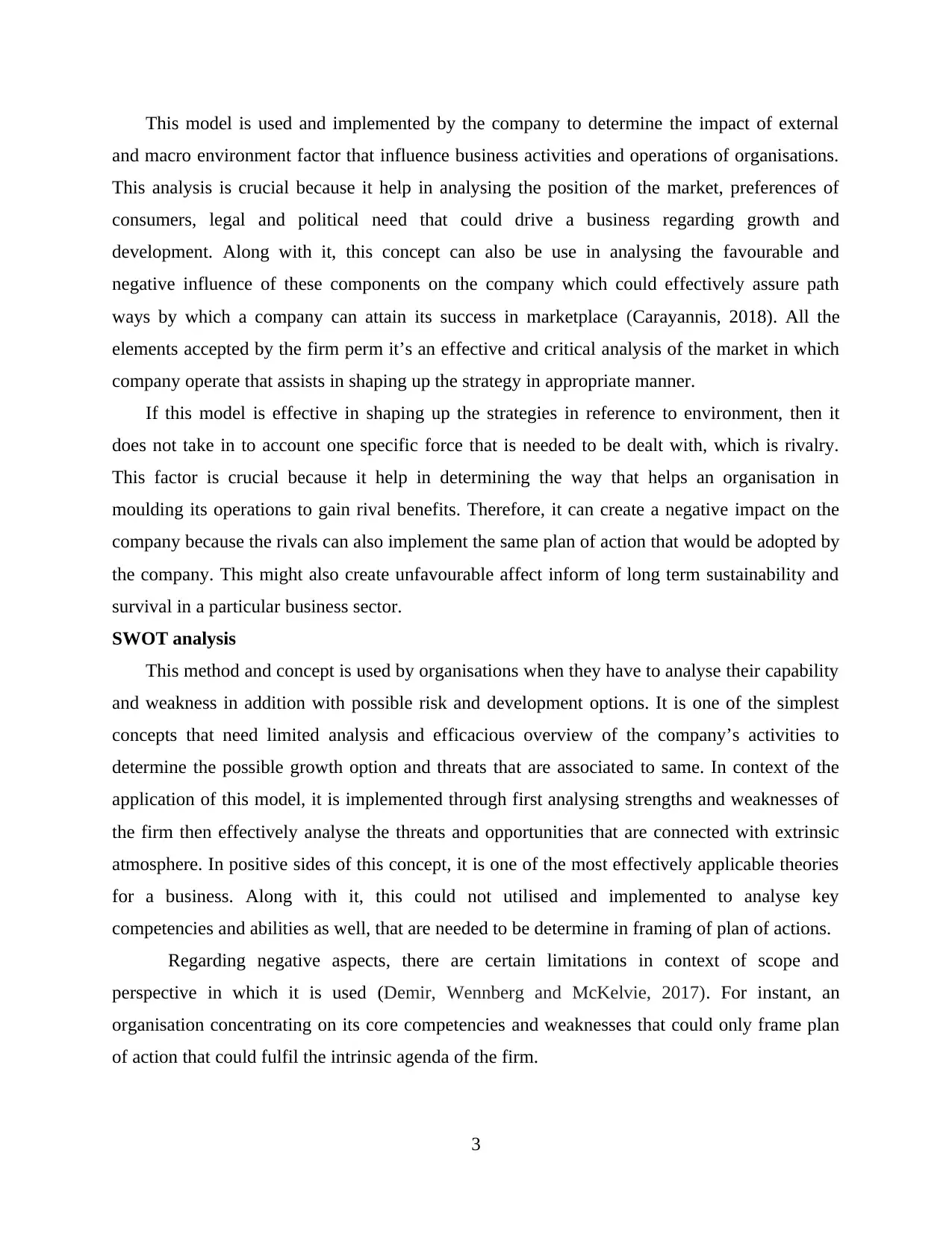
This model is used and implemented by the company to determine the impact of external
and macro environment factor that influence business activities and operations of organisations.
This analysis is crucial because it help in analysing the position of the market, preferences of
consumers, legal and political need that could drive a business regarding growth and
development. Along with it, this concept can also be use in analysing the favourable and
negative influence of these components on the company which could effectively assure path
ways by which a company can attain its success in marketplace (Carayannis, 2018). All the
elements accepted by the firm perm it’s an effective and critical analysis of the market in which
company operate that assists in shaping up the strategy in appropriate manner.
If this model is effective in shaping up the strategies in reference to environment, then it
does not take in to account one specific force that is needed to be dealt with, which is rivalry.
This factor is crucial because it help in determining the way that helps an organisation in
moulding its operations to gain rival benefits. Therefore, it can create a negative impact on the
company because the rivals can also implement the same plan of action that would be adopted by
the company. This might also create unfavourable affect inform of long term sustainability and
survival in a particular business sector.
SWOT analysis
This method and concept is used by organisations when they have to analyse their capability
and weakness in addition with possible risk and development options. It is one of the simplest
concepts that need limited analysis and efficacious overview of the company’s activities to
determine the possible growth option and threats that are associated to same. In context of the
application of this model, it is implemented through first analysing strengths and weaknesses of
the firm then effectively analyse the threats and opportunities that are connected with extrinsic
atmosphere. In positive sides of this concept, it is one of the most effectively applicable theories
for a business. Along with it, this could not utilised and implemented to analyse key
competencies and abilities as well, that are needed to be determine in framing of plan of actions.
Regarding negative aspects, there are certain limitations in context of scope and
perspective in which it is used (Demir, Wennberg and McKelvie, 2017). For instant, an
organisation concentrating on its core competencies and weaknesses that could only frame plan
of action that could fulfil the intrinsic agenda of the firm.
3
and macro environment factor that influence business activities and operations of organisations.
This analysis is crucial because it help in analysing the position of the market, preferences of
consumers, legal and political need that could drive a business regarding growth and
development. Along with it, this concept can also be use in analysing the favourable and
negative influence of these components on the company which could effectively assure path
ways by which a company can attain its success in marketplace (Carayannis, 2018). All the
elements accepted by the firm perm it’s an effective and critical analysis of the market in which
company operate that assists in shaping up the strategy in appropriate manner.
If this model is effective in shaping up the strategies in reference to environment, then it
does not take in to account one specific force that is needed to be dealt with, which is rivalry.
This factor is crucial because it help in determining the way that helps an organisation in
moulding its operations to gain rival benefits. Therefore, it can create a negative impact on the
company because the rivals can also implement the same plan of action that would be adopted by
the company. This might also create unfavourable affect inform of long term sustainability and
survival in a particular business sector.
SWOT analysis
This method and concept is used by organisations when they have to analyse their capability
and weakness in addition with possible risk and development options. It is one of the simplest
concepts that need limited analysis and efficacious overview of the company’s activities to
determine the possible growth option and threats that are associated to same. In context of the
application of this model, it is implemented through first analysing strengths and weaknesses of
the firm then effectively analyse the threats and opportunities that are connected with extrinsic
atmosphere. In positive sides of this concept, it is one of the most effectively applicable theories
for a business. Along with it, this could not utilised and implemented to analyse key
competencies and abilities as well, that are needed to be determine in framing of plan of actions.
Regarding negative aspects, there are certain limitations in context of scope and
perspective in which it is used (Demir, Wennberg and McKelvie, 2017). For instant, an
organisation concentrating on its core competencies and weaknesses that could only frame plan
of action that could fulfil the intrinsic agenda of the firm.
3

However, both models have their own advantages and limitations that are required to be
measured and determined by the management of the firm to formulate a strategy that able to
fulfils agendas of these both concepts in effective way.
Application of these tools in context of the company
SWOT analysis of Tesco
It is a strategic analysis that is used by the management of Tesco to analyse the internal
environment. With the implementation of this framework, the administration can determine the
capability, weaknesses, growth options and threats of the organisation (Gans and Ryall, 2017). In
context of respective company SWOT analysis is explained as below:
Strengths Weaknesses
Tesco is one of the biggest grocery
stores in UK which operate its business
with the help of more than 6800 stores
approx 14 nations cross wise the world.
The organisation use technology in the
best optimal way to improve the
shopping experience of its target
audiences.
The main weakness of the company is
fraud trail and accounting scandal affect
the believe and trust of customers.
Tesco is price leader in UK market but
low price strategy lead to decreased
profit margins.
Opportunities Threats
Recently, Tesco introduced Jacks, a
new discount store which has displayed
effective development and growth or
help in offering a business growth
option.
By adopting technologies in its
business in term of online shopping and
offering option of home delivery
services.
There are number of grocery company
which create high level competition by
offering substitute products and
services.
Brexit and drastically political situation
also generate threats for business of
Tesco (Ginter, Duncan and Swayne,
2018).
PESTEL analysis of Tesco
4
measured and determined by the management of the firm to formulate a strategy that able to
fulfils agendas of these both concepts in effective way.
Application of these tools in context of the company
SWOT analysis of Tesco
It is a strategic analysis that is used by the management of Tesco to analyse the internal
environment. With the implementation of this framework, the administration can determine the
capability, weaknesses, growth options and threats of the organisation (Gans and Ryall, 2017). In
context of respective company SWOT analysis is explained as below:
Strengths Weaknesses
Tesco is one of the biggest grocery
stores in UK which operate its business
with the help of more than 6800 stores
approx 14 nations cross wise the world.
The organisation use technology in the
best optimal way to improve the
shopping experience of its target
audiences.
The main weakness of the company is
fraud trail and accounting scandal affect
the believe and trust of customers.
Tesco is price leader in UK market but
low price strategy lead to decreased
profit margins.
Opportunities Threats
Recently, Tesco introduced Jacks, a
new discount store which has displayed
effective development and growth or
help in offering a business growth
option.
By adopting technologies in its
business in term of online shopping and
offering option of home delivery
services.
There are number of grocery company
which create high level competition by
offering substitute products and
services.
Brexit and drastically political situation
also generate threats for business of
Tesco (Ginter, Duncan and Swayne,
2018).
PESTEL analysis of Tesco
4
⊘ This is a preview!⊘
Do you want full access?
Subscribe today to unlock all pages.

Trusted by 1+ million students worldwide
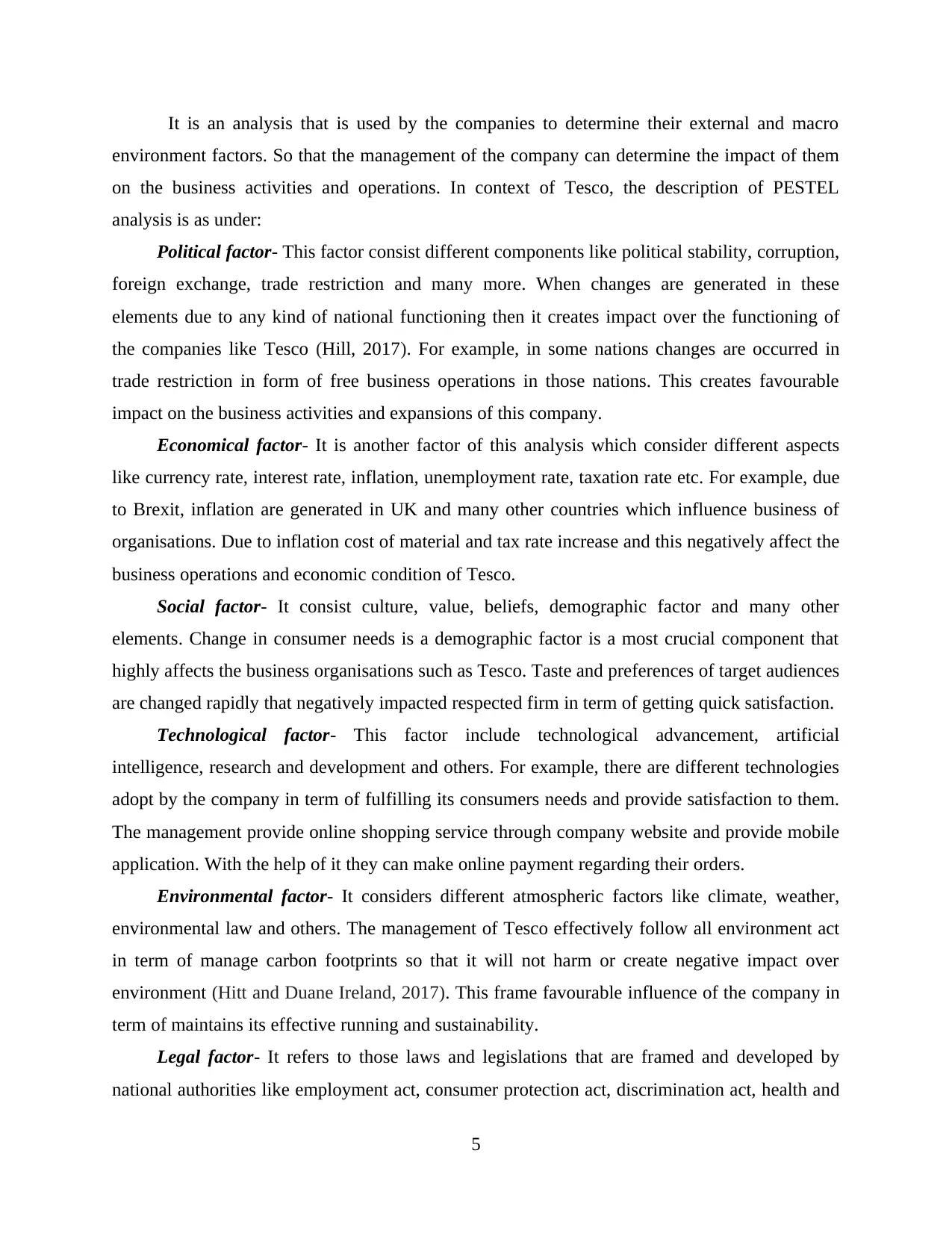
It is an analysis that is used by the companies to determine their external and macro
environment factors. So that the management of the company can determine the impact of them
on the business activities and operations. In context of Tesco, the description of PESTEL
analysis is as under:
Political factor- This factor consist different components like political stability, corruption,
foreign exchange, trade restriction and many more. When changes are generated in these
elements due to any kind of national functioning then it creates impact over the functioning of
the companies like Tesco (Hill, 2017). For example, in some nations changes are occurred in
trade restriction in form of free business operations in those nations. This creates favourable
impact on the business activities and expansions of this company.
Economical factor- It is another factor of this analysis which consider different aspects
like currency rate, interest rate, inflation, unemployment rate, taxation rate etc. For example, due
to Brexit, inflation are generated in UK and many other countries which influence business of
organisations. Due to inflation cost of material and tax rate increase and this negatively affect the
business operations and economic condition of Tesco.
Social factor- It consist culture, value, beliefs, demographic factor and many other
elements. Change in consumer needs is a demographic factor is a most crucial component that
highly affects the business organisations such as Tesco. Taste and preferences of target audiences
are changed rapidly that negatively impacted respected firm in term of getting quick satisfaction.
Technological factor- This factor include technological advancement, artificial
intelligence, research and development and others. For example, there are different technologies
adopt by the company in term of fulfilling its consumers needs and provide satisfaction to them.
The management provide online shopping service through company website and provide mobile
application. With the help of it they can make online payment regarding their orders.
Environmental factor- It considers different atmospheric factors like climate, weather,
environmental law and others. The management of Tesco effectively follow all environment act
in term of manage carbon footprints so that it will not harm or create negative impact over
environment (Hitt and Duane Ireland, 2017). This frame favourable influence of the company in
term of maintains its effective running and sustainability.
Legal factor- It refers to those laws and legislations that are framed and developed by
national authorities like employment act, consumer protection act, discrimination act, health and
5
environment factors. So that the management of the company can determine the impact of them
on the business activities and operations. In context of Tesco, the description of PESTEL
analysis is as under:
Political factor- This factor consist different components like political stability, corruption,
foreign exchange, trade restriction and many more. When changes are generated in these
elements due to any kind of national functioning then it creates impact over the functioning of
the companies like Tesco (Hill, 2017). For example, in some nations changes are occurred in
trade restriction in form of free business operations in those nations. This creates favourable
impact on the business activities and expansions of this company.
Economical factor- It is another factor of this analysis which consider different aspects
like currency rate, interest rate, inflation, unemployment rate, taxation rate etc. For example, due
to Brexit, inflation are generated in UK and many other countries which influence business of
organisations. Due to inflation cost of material and tax rate increase and this negatively affect the
business operations and economic condition of Tesco.
Social factor- It consist culture, value, beliefs, demographic factor and many other
elements. Change in consumer needs is a demographic factor is a most crucial component that
highly affects the business organisations such as Tesco. Taste and preferences of target audiences
are changed rapidly that negatively impacted respected firm in term of getting quick satisfaction.
Technological factor- This factor include technological advancement, artificial
intelligence, research and development and others. For example, there are different technologies
adopt by the company in term of fulfilling its consumers needs and provide satisfaction to them.
The management provide online shopping service through company website and provide mobile
application. With the help of it they can make online payment regarding their orders.
Environmental factor- It considers different atmospheric factors like climate, weather,
environmental law and others. The management of Tesco effectively follow all environment act
in term of manage carbon footprints so that it will not harm or create negative impact over
environment (Hitt and Duane Ireland, 2017). This frame favourable influence of the company in
term of maintains its effective running and sustainability.
Legal factor- It refers to those laws and legislations that are framed and developed by
national authorities like employment act, consumer protection act, discrimination act, health and
5
Paraphrase This Document
Need a fresh take? Get an instant paraphrase of this document with our AI Paraphraser
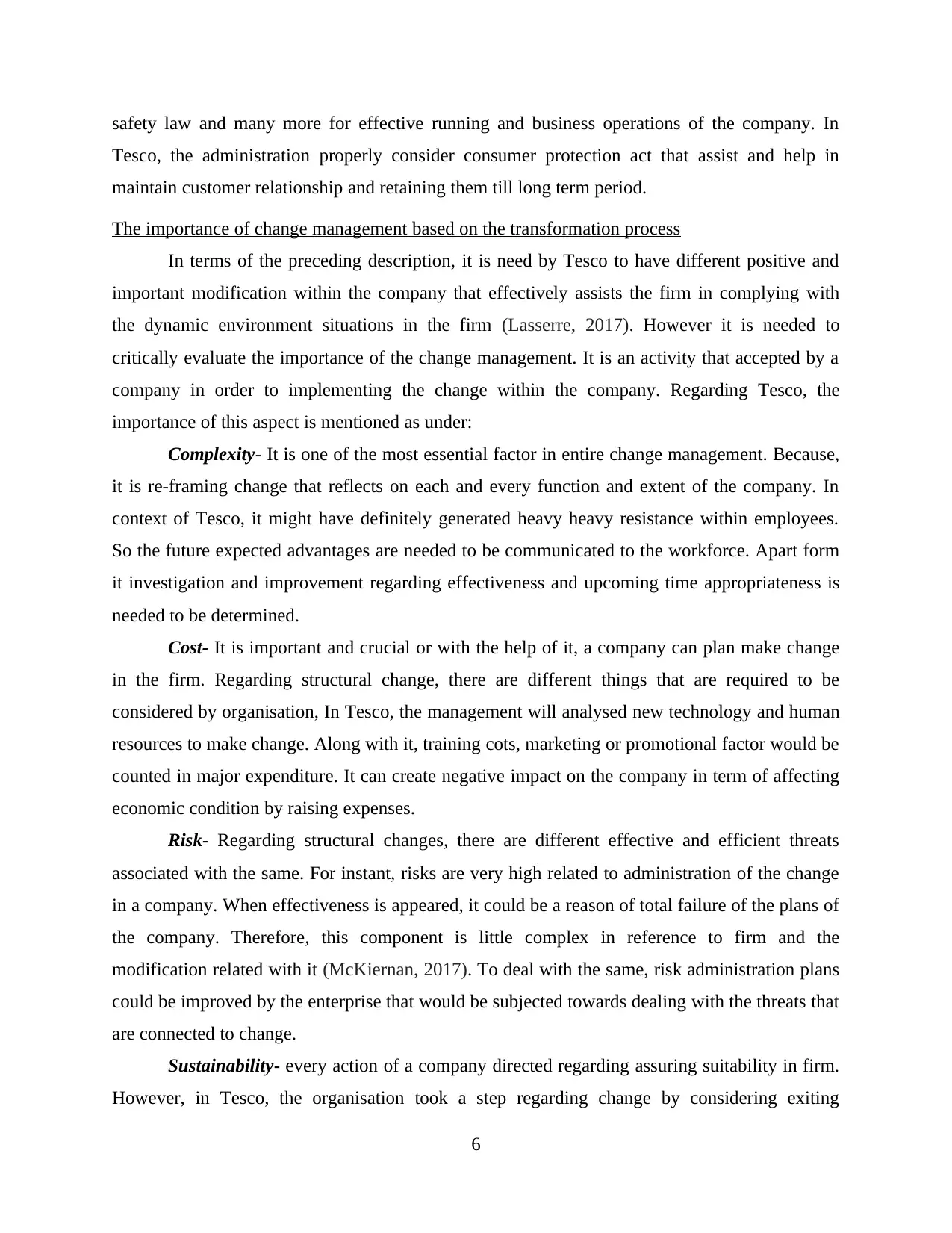
safety law and many more for effective running and business operations of the company. In
Tesco, the administration properly consider consumer protection act that assist and help in
maintain customer relationship and retaining them till long term period.
The importance of change management based on the transformation process
In terms of the preceding description, it is need by Tesco to have different positive and
important modification within the company that effectively assists the firm in complying with
the dynamic environment situations in the firm (Lasserre, 2017). However it is needed to
critically evaluate the importance of the change management. It is an activity that accepted by a
company in order to implementing the change within the company. Regarding Tesco, the
importance of this aspect is mentioned as under:
Complexity- It is one of the most essential factor in entire change management. Because,
it is re-framing change that reflects on each and every function and extent of the company. In
context of Tesco, it might have definitely generated heavy heavy resistance within employees.
So the future expected advantages are needed to be communicated to the workforce. Apart form
it investigation and improvement regarding effectiveness and upcoming time appropriateness is
needed to be determined.
Cost- It is important and crucial or with the help of it, a company can plan make change
in the firm. Regarding structural change, there are different things that are required to be
considered by organisation, In Tesco, the management will analysed new technology and human
resources to make change. Along with it, training cots, marketing or promotional factor would be
counted in major expenditure. It can create negative impact on the company in term of affecting
economic condition by raising expenses.
Risk- Regarding structural changes, there are different effective and efficient threats
associated with the same. For instant, risks are very high related to administration of the change
in a company. When effectiveness is appeared, it could be a reason of total failure of the plans of
the company. Therefore, this component is little complex in reference to firm and the
modification related with it (McKiernan, 2017). To deal with the same, risk administration plans
could be improved by the enterprise that would be subjected towards dealing with the threats that
are connected to change.
Sustainability- every action of a company directed regarding assuring suitability in firm.
However, in Tesco, the organisation took a step regarding change by considering exiting
6
Tesco, the administration properly consider consumer protection act that assist and help in
maintain customer relationship and retaining them till long term period.
The importance of change management based on the transformation process
In terms of the preceding description, it is need by Tesco to have different positive and
important modification within the company that effectively assists the firm in complying with
the dynamic environment situations in the firm (Lasserre, 2017). However it is needed to
critically evaluate the importance of the change management. It is an activity that accepted by a
company in order to implementing the change within the company. Regarding Tesco, the
importance of this aspect is mentioned as under:
Complexity- It is one of the most essential factor in entire change management. Because,
it is re-framing change that reflects on each and every function and extent of the company. In
context of Tesco, it might have definitely generated heavy heavy resistance within employees.
So the future expected advantages are needed to be communicated to the workforce. Apart form
it investigation and improvement regarding effectiveness and upcoming time appropriateness is
needed to be determined.
Cost- It is important and crucial or with the help of it, a company can plan make change
in the firm. Regarding structural change, there are different things that are required to be
considered by organisation, In Tesco, the management will analysed new technology and human
resources to make change. Along with it, training cots, marketing or promotional factor would be
counted in major expenditure. It can create negative impact on the company in term of affecting
economic condition by raising expenses.
Risk- Regarding structural changes, there are different effective and efficient threats
associated with the same. For instant, risks are very high related to administration of the change
in a company. When effectiveness is appeared, it could be a reason of total failure of the plans of
the company. Therefore, this component is little complex in reference to firm and the
modification related with it (McKiernan, 2017). To deal with the same, risk administration plans
could be improved by the enterprise that would be subjected towards dealing with the threats that
are connected to change.
Sustainability- every action of a company directed regarding assuring suitability in firm.
However, in Tesco, the organisation took a step regarding change by considering exiting
6
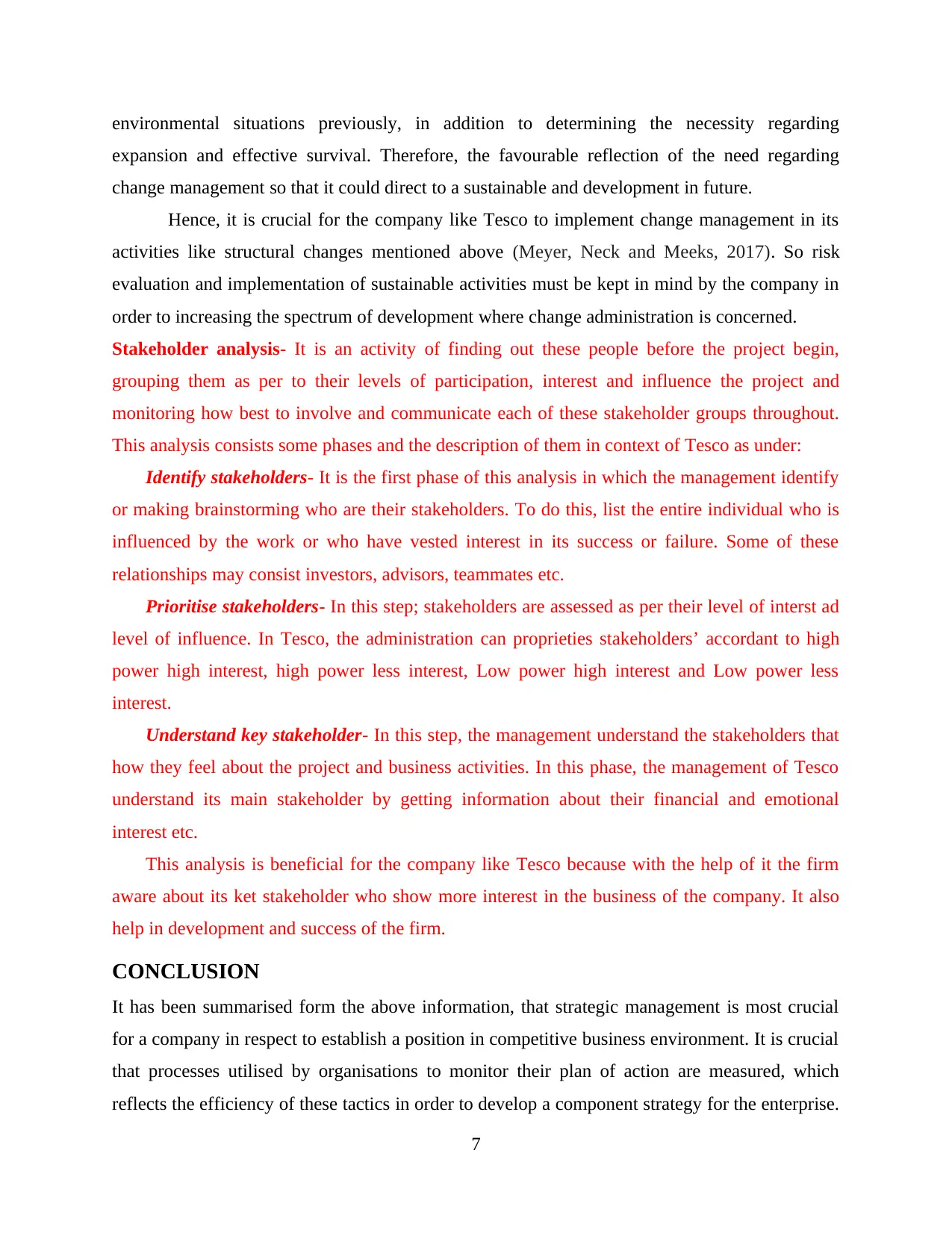
environmental situations previously, in addition to determining the necessity regarding
expansion and effective survival. Therefore, the favourable reflection of the need regarding
change management so that it could direct to a sustainable and development in future.
Hence, it is crucial for the company like Tesco to implement change management in its
activities like structural changes mentioned above (Meyer, Neck and Meeks, 2017). So risk
evaluation and implementation of sustainable activities must be kept in mind by the company in
order to increasing the spectrum of development where change administration is concerned.
Stakeholder analysis- It is an activity of finding out these people before the project begin,
grouping them as per to their levels of participation, interest and influence the project and
monitoring how best to involve and communicate each of these stakeholder groups throughout.
This analysis consists some phases and the description of them in context of Tesco as under:
Identify stakeholders- It is the first phase of this analysis in which the management identify
or making brainstorming who are their stakeholders. To do this, list the entire individual who is
influenced by the work or who have vested interest in its success or failure. Some of these
relationships may consist investors, advisors, teammates etc.
Prioritise stakeholders- In this step; stakeholders are assessed as per their level of interst ad
level of influence. In Tesco, the administration can proprieties stakeholders’ accordant to high
power high interest, high power less interest, Low power high interest and Low power less
interest.
Understand key stakeholder- In this step, the management understand the stakeholders that
how they feel about the project and business activities. In this phase, the management of Tesco
understand its main stakeholder by getting information about their financial and emotional
interest etc.
This analysis is beneficial for the company like Tesco because with the help of it the firm
aware about its ket stakeholder who show more interest in the business of the company. It also
help in development and success of the firm.
CONCLUSION
It has been summarised form the above information, that strategic management is most crucial
for a company in respect to establish a position in competitive business environment. It is crucial
that processes utilised by organisations to monitor their plan of action are measured, which
reflects the efficiency of these tactics in order to develop a component strategy for the enterprise.
7
expansion and effective survival. Therefore, the favourable reflection of the need regarding
change management so that it could direct to a sustainable and development in future.
Hence, it is crucial for the company like Tesco to implement change management in its
activities like structural changes mentioned above (Meyer, Neck and Meeks, 2017). So risk
evaluation and implementation of sustainable activities must be kept in mind by the company in
order to increasing the spectrum of development where change administration is concerned.
Stakeholder analysis- It is an activity of finding out these people before the project begin,
grouping them as per to their levels of participation, interest and influence the project and
monitoring how best to involve and communicate each of these stakeholder groups throughout.
This analysis consists some phases and the description of them in context of Tesco as under:
Identify stakeholders- It is the first phase of this analysis in which the management identify
or making brainstorming who are their stakeholders. To do this, list the entire individual who is
influenced by the work or who have vested interest in its success or failure. Some of these
relationships may consist investors, advisors, teammates etc.
Prioritise stakeholders- In this step; stakeholders are assessed as per their level of interst ad
level of influence. In Tesco, the administration can proprieties stakeholders’ accordant to high
power high interest, high power less interest, Low power high interest and Low power less
interest.
Understand key stakeholder- In this step, the management understand the stakeholders that
how they feel about the project and business activities. In this phase, the management of Tesco
understand its main stakeholder by getting information about their financial and emotional
interest etc.
This analysis is beneficial for the company like Tesco because with the help of it the firm
aware about its ket stakeholder who show more interest in the business of the company. It also
help in development and success of the firm.
CONCLUSION
It has been summarised form the above information, that strategic management is most crucial
for a company in respect to establish a position in competitive business environment. It is crucial
that processes utilised by organisations to monitor their plan of action are measured, which
reflects the efficiency of these tactics in order to develop a component strategy for the enterprise.
7
⊘ This is a preview!⊘
Do you want full access?
Subscribe today to unlock all pages.

Trusted by 1+ million students worldwide
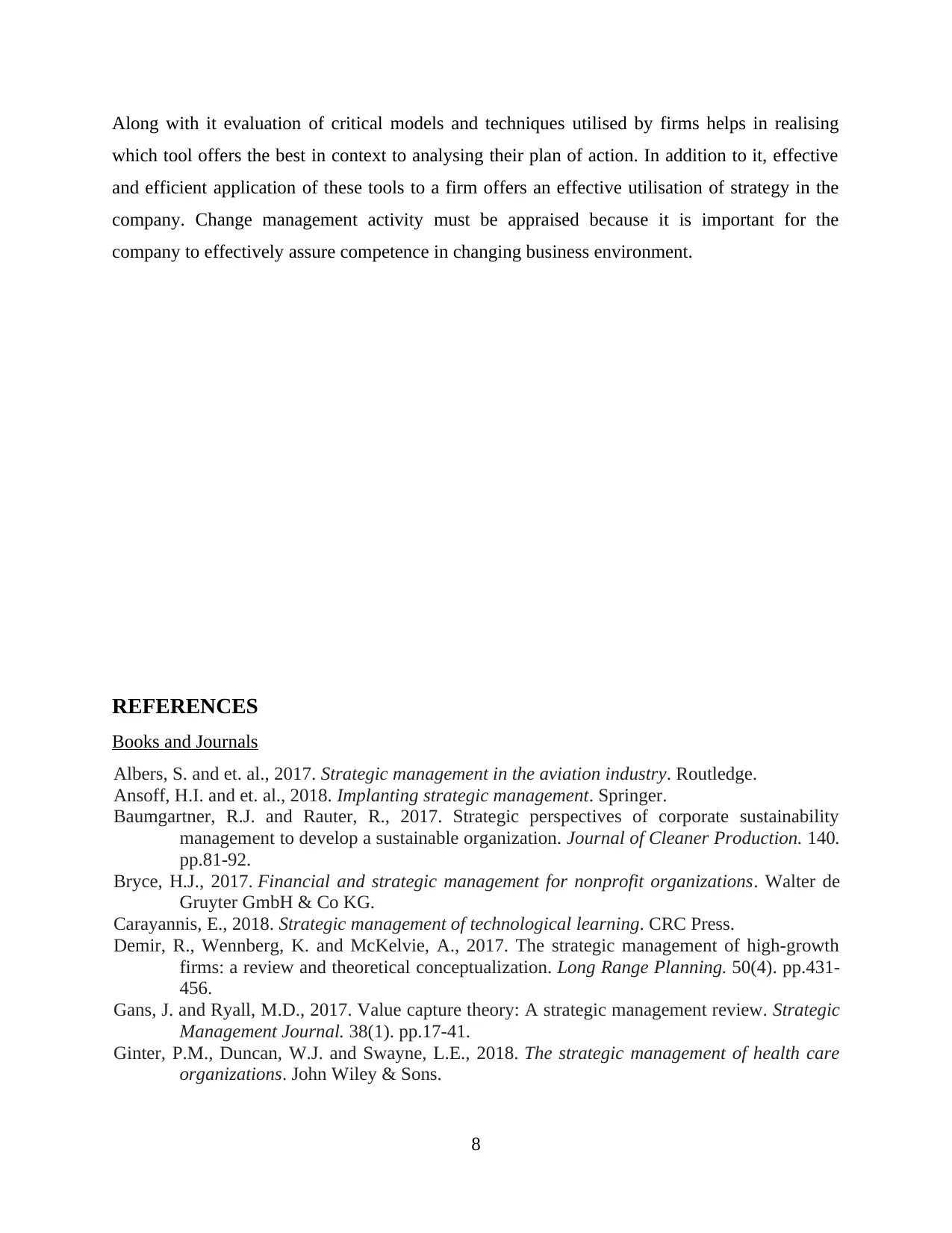
Along with it evaluation of critical models and techniques utilised by firms helps in realising
which tool offers the best in context to analysing their plan of action. In addition to it, effective
and efficient application of these tools to a firm offers an effective utilisation of strategy in the
company. Change management activity must be appraised because it is important for the
company to effectively assure competence in changing business environment.
REFERENCES
Books and Journals
Albers, S. and et. al., 2017. Strategic management in the aviation industry. Routledge.
Ansoff, H.I. and et. al., 2018. Implanting strategic management. Springer.
Baumgartner, R.J. and Rauter, R., 2017. Strategic perspectives of corporate sustainability
management to develop a sustainable organization. Journal of Cleaner Production. 140.
pp.81-92.
Bryce, H.J., 2017. Financial and strategic management for nonprofit organizations. Walter de
Gruyter GmbH & Co KG.
Carayannis, E., 2018. Strategic management of technological learning. CRC Press.
Demir, R., Wennberg, K. and McKelvie, A., 2017. The strategic management of high-growth
firms: a review and theoretical conceptualization. Long Range Planning. 50(4). pp.431-
456.
Gans, J. and Ryall, M.D., 2017. Value capture theory: A strategic management review. Strategic
Management Journal. 38(1). pp.17-41.
Ginter, P.M., Duncan, W.J. and Swayne, L.E., 2018. The strategic management of health care
organizations. John Wiley & Sons.
8
which tool offers the best in context to analysing their plan of action. In addition to it, effective
and efficient application of these tools to a firm offers an effective utilisation of strategy in the
company. Change management activity must be appraised because it is important for the
company to effectively assure competence in changing business environment.
REFERENCES
Books and Journals
Albers, S. and et. al., 2017. Strategic management in the aviation industry. Routledge.
Ansoff, H.I. and et. al., 2018. Implanting strategic management. Springer.
Baumgartner, R.J. and Rauter, R., 2017. Strategic perspectives of corporate sustainability
management to develop a sustainable organization. Journal of Cleaner Production. 140.
pp.81-92.
Bryce, H.J., 2017. Financial and strategic management for nonprofit organizations. Walter de
Gruyter GmbH & Co KG.
Carayannis, E., 2018. Strategic management of technological learning. CRC Press.
Demir, R., Wennberg, K. and McKelvie, A., 2017. The strategic management of high-growth
firms: a review and theoretical conceptualization. Long Range Planning. 50(4). pp.431-
456.
Gans, J. and Ryall, M.D., 2017. Value capture theory: A strategic management review. Strategic
Management Journal. 38(1). pp.17-41.
Ginter, P.M., Duncan, W.J. and Swayne, L.E., 2018. The strategic management of health care
organizations. John Wiley & Sons.
8
Paraphrase This Document
Need a fresh take? Get an instant paraphrase of this document with our AI Paraphraser

Hill, T., 2017. Manufacturing strategy: the strategic management of the manufacturing function.
Macmillan International Higher Education.
Hitt, M. and Duane Ireland, R., 2017. The intersection of entrepreneurship and strategic
management research. The Blackwell handbook of entrepreneurship, pp.45-63.
Lasserre, P., 2017. Global strategic management. Macmillan International Higher Education.
McKiernan, P., 2017. Historical Evolution of Strategic Management, Volumes I and II.
Routledge.
Meyer, G.D., Neck, H.M. and Meeks, M.D., 2017. The entrepreneurship‐strategic management
interface. Strategic entrepreneurship: Creating a new mindset. pp.17-44.
Moutinho, L. and Vargas-Sanchez, A. eds., 2018. Strategic Management in Tourism, CABI
Tourism Texts. Cabi.
Okumus, F. and et. al., 2019. Strategic management for hospitality and tourism. Routledge.
Trigeorgis, L. and Reuer, J.J., 2017. Real options theory in strategic management. Strategic
Management Journal. 38(1). pp.42-63.
Zhao, E.Y. and et. al., 2017. Optimal distinctiveness: Broadening the interface between
institutional theory and strategic management. Strategic Management Journal. 38(1).
pp.93-113.
9
Macmillan International Higher Education.
Hitt, M. and Duane Ireland, R., 2017. The intersection of entrepreneurship and strategic
management research. The Blackwell handbook of entrepreneurship, pp.45-63.
Lasserre, P., 2017. Global strategic management. Macmillan International Higher Education.
McKiernan, P., 2017. Historical Evolution of Strategic Management, Volumes I and II.
Routledge.
Meyer, G.D., Neck, H.M. and Meeks, M.D., 2017. The entrepreneurship‐strategic management
interface. Strategic entrepreneurship: Creating a new mindset. pp.17-44.
Moutinho, L. and Vargas-Sanchez, A. eds., 2018. Strategic Management in Tourism, CABI
Tourism Texts. Cabi.
Okumus, F. and et. al., 2019. Strategic management for hospitality and tourism. Routledge.
Trigeorgis, L. and Reuer, J.J., 2017. Real options theory in strategic management. Strategic
Management Journal. 38(1). pp.42-63.
Zhao, E.Y. and et. al., 2017. Optimal distinctiveness: Broadening the interface between
institutional theory and strategic management. Strategic Management Journal. 38(1).
pp.93-113.
9
1 out of 11
Related Documents
Your All-in-One AI-Powered Toolkit for Academic Success.
+13062052269
info@desklib.com
Available 24*7 on WhatsApp / Email
![[object Object]](/_next/static/media/star-bottom.7253800d.svg)
Unlock your academic potential
Copyright © 2020–2025 A2Z Services. All Rights Reserved. Developed and managed by ZUCOL.





